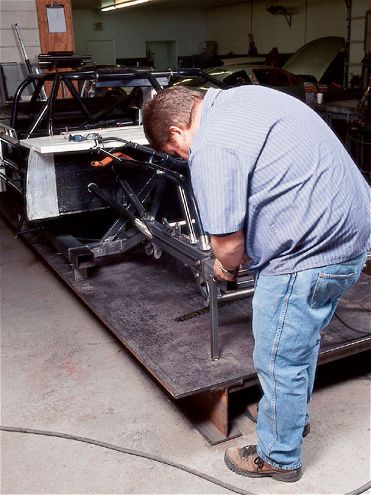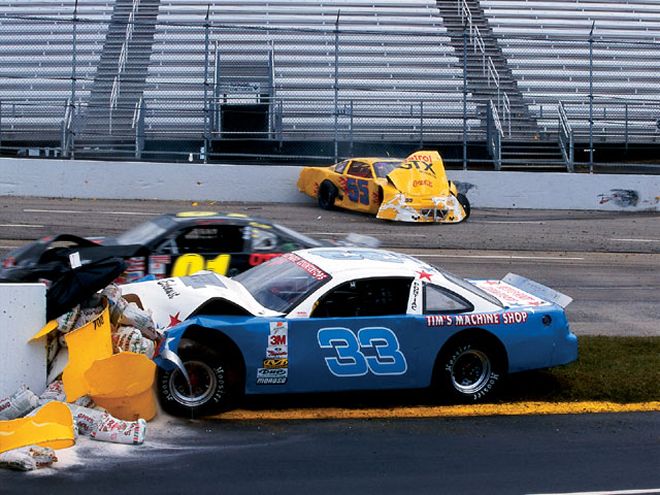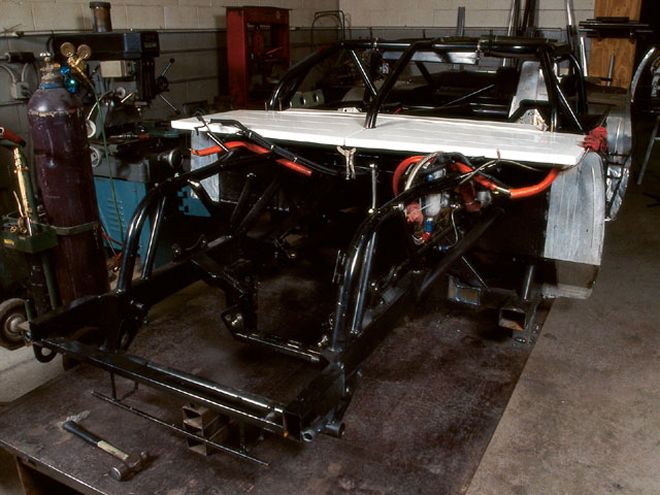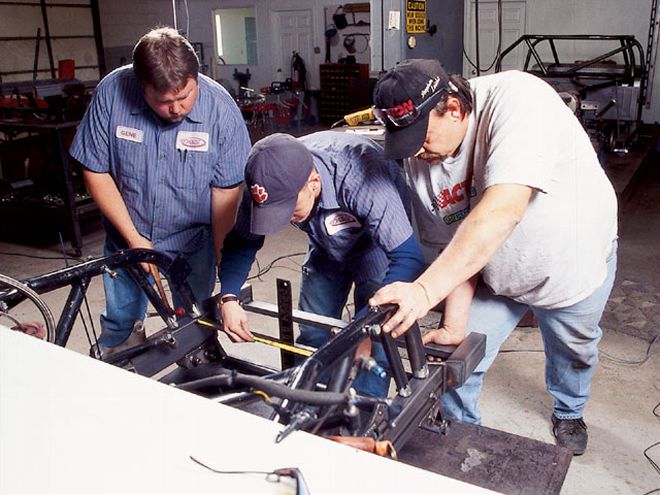
 The events that can require you to reclip your race car aren't always this severe, but you get the picture. Thankfully, the driver walked away from this wreck.
The events that can require you to reclip your race car aren't always this severe, but you get the picture. Thankfully, the driver walked away from this wreck.
Don't worry, it happens to everybody. Bumps and scrapes, that type of thing. We're not talking about your ill-advised attempt to ride your son's skateboard; we're talking about your race car. If you think you can go racing without ever banging a fender or two, you probably need to trade in your stock car for slot cars. Bent metal happens, it's not the end of the world.
But that means occasionally your car is probably going to have to go under the knife. That's obvious in the opening photo-happily, the driver walked away-but there are other occasions when the handling just isn't quite right and the only solution is to replace the front clip. To see how it's done we visited Gene Leicht of Leicht Race Cars in Arden, N.C. Leicht and his crew were at work on a car that is a much more common example than the "big wreck." This Late Model had, at some point during the season, been punched in the tire. After that, no matter what adjustments the team made, the driver felt it was never quite right. So, as soon as the season was over the car was sent in for a real fix: a new front end.
Leicht Race Cars is a no-frills chassis shop. It specializes in Late Model chassis, and although Leicht's shop is by no means a large-production operation, his strong, lightweight chassis have won races all over the Southeast. Although there may be minor differences in operation, the process for replacing a front clip on a tubular chassis is nearly identical in every race shop across the country. The key is the precision the shop is capable of and how much pride your chassis builder takes in his repair work.
All chassis repair work is done on one of Leicht's two surface plates. This one is a single plate of steel six feet wide by sixteen feet long and five-eighths of an inch thick. It rests on two giant I beams secured to the floor. To ensure that it stays perfectly level Leicht regularly shoots it with a surveyor's transit. It may seem like a waste of time, but Leicht says things move, the floor of the shop settles or the surface plate simply gets knocked around moving wrecked cars on and off it.
 This car came into Leicht Race Cars for a new front clip. The damage doesn't look severe, but a punch to one of the front wheels knocked the brackets out of alignment. The team shortened the time the car spent in the shop (and their bill) by removing everything from the front end and allowing Leicht and his crew to get right down to work.
This car came into Leicht Race Cars for a new front clip. The damage doesn't look severe, but a punch to one of the front wheels knocked the brackets out of alignment. The team shortened the time the car spent in the shop (and their bill) by removing everything from the front end and allowing Leicht and his crew to get right down to work.
For every car Leicht repairs, four new four-inch blocks are cut to set the chassis on. A scribed grid on the surface plate helps center the car on the plate, and once everything is centered and confirmed as level, the car is welded to the blocks and the blocks, in turn, are welded to the surface plate to make sure nothing can accidentally get bumped out of position.
If it hasn't already been done, everything unnecessary is stripped from the front end of the car and the cutting begins. Leicht uses a cutting torch, saying it's quicker than a saw and easier to use on difficult angles than a plasma cutter. Two passes are made with the cutting torch: The first to do the big work and separate the clip from the framerails and the upper engine cage tubing, and the second to do the detail work and clean up the tubing to be rewelded. Everything is then ground smooth.
Most chassis builders pre-fabricate a clip for their own cars and can have it ready before your car arrives at the shop. Since the car we are working on is one Leicht had built, he had a clip ready to go as soon as the old one was cut off. Leicht's clips rest on a notch against a crossmember underneath the firewall. A measured block holds the front of the clip at the correct height. Before the first arc is struck with the welder, Leicht spends a significant amount of time making sure everything is straight. It does no good to have a new front clip if it isn't aligned with the car, so knowing everything is situated perfectly is critical. Leicht has specific points on his chassis he measures to make sure he's getting what he wants. The car is already centered on the surface plate, so the clip needs only to be centered on the centered line scribed into the plate. It's located forward and back by measuring from between the central crossmember in the car to the engine-mount crossmember on the clip. Height from the surface plate is also checked all the way around.
 Lateral location is verified using a line scribed down the center of the surface plate and a framer's square.
Lateral location is verified using a line scribed down the center of the surface plate and a framer's square.
Next all the locations connecting the car to the clip are checked. If there's a gap of more than an eighth of an inch that tube is replaced or refitted. While welding, Leicht first tacks everything in place and then goes back around. To keep excessive heat from building up and pulling the clip out of alignment before all its locations are secured, the welder will jump from bar to bar on the clip, never welding in one area for too long.
After everything is welded up it's time to get familiar with a tape measure all over again and recheck all critical measurements. Then, if the customer has requested, Leicht begins refitting suspension pieces and body panels.
Sounds easy. Basically, it is, according to Leicht. "Reclipping a car isn't a difficult process," he says, "but whoever is doing it must have the equipment and the skills to get it right and know when he's got it right. It's not something you can adjust after you've got it welded up." That's why most chassis builders insist you bring a car in need of reclipping into their shop and don't ship out clips as a part number.
 Once the new clip is properly located, Leicht uses square tubing to tack-weld the clip to the surface place and lock in its location vertically. He then tacks all the mounting points between the car and the new clip.
Once the new clip is properly located, Leicht uses square tubing to tack-weld the clip to the surface place and lock in its location vertically. He then tacks all the mounting points between the car and the new clip.
The total time on our project car was a day (it came in already stripped, and Leicht had the new clip ready and waiting). Total cost to the customer was $1,350. Not a bad investment when it comes to getting your car back as good as new.
Make It Easy on Me
Is your chassis builder perennially behind and you need your car back in a hurry? Make things as easy on him as possible. Before sending your car in to be reclipped, pull the engine, radiator, steering box and everything else you can. If you can, Leicht suggests stripping the wheels and suspension, including the rear end, and rolling the car in on dollies. Time is money, and any time you save the chassis builder is money you don't have to spend.
What about body panels? "If you are going to reskin the car yourself, then go ahead and cut it all off," Leicht suggests. "But teams almost always want me to put a new nose and fenders on the car while I have it. If that's the case, leave it in place. That way I can reuse any brackets that are still good and save that team a little money."